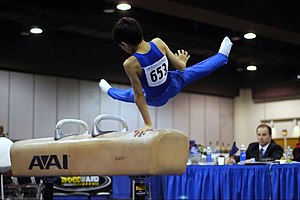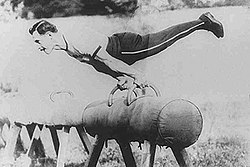Pommel horse

The pommel horse is an artistic gymnastics apparatus. Traditionally, it is used by only male gymnasts. Originally made of a metal frame with a wooden body and a leather cover, the modern pommel horse has a metal body covered with foam rubber and leather, with plastic handles (or pommels).[1]
Apparatus[]
History[]
This section needs expansion. You can help by . (October 2010) |

Dimensions[]
Measurements of the apparatus are published by the Fédération Internationale de Gymnastique (FIG) in the Apparatus Norms brochure.[2]
- Height from top surface to floor: 115 centimetres (3.77 ft) ± 1 centimetre (0.39 in)
- Length at top: 160 centimetres (5.2 ft) ± 1 centimetre (0.39 in)
- Length at bottom: 155 centimetres (5.09 ft) ± 1 centimetre (0.39 in)
- Width at top: 35 centimetres (14 in) ± 1 centimetre (0.39 in)
- Width at bottom: 30 centimetres (12 in) ± 1 centimetre (0.39 in)
- Height of the pommels: 12 centimetres (4.7 in) ± 0.5 centimetres (0.20 in)
- Distance between the pommels: 40 centimetres (16 in) – 45 centimetres (18 in) (adjustable)
Routines[]

A typical pommel horse exercise involves both single leg and double leg work. Single leg skills are generally in the form of scissors. Double leg work however, is the main staple of this event. The gymnast swings both legs in a circular motion (clockwise or counterclockwise depending on preference) and performs such skills on all parts of the apparatus. To make the exercise more challenging, gymnasts will often include variations on a typical circling skill by turning (moores and spindles), by straddling their legs (Flairs), placing one or both hands on the pommel or the leather, or moving up and down the horse placing their hands on the pommel and/or the leather (travelling). Routines end when the gymnast performs a dismount, either by swinging his body over the horse or going through a handstand to land on the mat. The pommel horse, its gymnastic elements, and various rules are all regulated by the Code of Points.
Pommel horse is considered one of the more difficult men's events.[3] While it is well noted that all events require a certain build of muscle and technique, pommel horse tends to favor technique over muscle. This is because horse routines are done from the shoulders in a leaning motion and that no moves need to be held, unlike other events. Therefore, stress induced in one's arms is reduced, meaning less muscle is needed in this event than events like still rings or parallel bars.
International level routines[]

A pommel horse routine should contain at least one element from all element groups:[4]
- Single leg swings and scissors
- Circles and flairs, with and/or without spindles and handstands
- Side and cross support travels
- Dismounts
Scoring and rules[]
As with all events in the Fédération Internationale de Gymnastique guidelines, form is crucial to any successful routine. For pommel horse, form consists of keeping one's feet pointed and legs straight during the entire routine. The gymnast should keep his legs together during all elements, exceptions beings scissors, single legged elements, and flairs.[4] Gymnasts are also deducted for not using all three sections of the horse and pausing or stopping on the apparatus.[4] Deductions also apply for brushing and hitting the apparatus.[5]
Olympic pommel horse medalists[]
The most decoated and successful Olympic pommel worker in history is Great Britain's Max Whitlock, with three medals including two gold medals. Two other gymnasts have three pommel horse Olympic medals across three Games; Romania's Marius Urzică with one gold and two silver medals, and Whitlock's compatriot and teammate Louis Smith with two silvers, and a bronze - under historic rules Smith would have shared gold in 2012, but was awarded silver behind Kristian Berki after a tie was broken on execution score.
Three other pommel workers have two Olympic gold medals, and each is considered a legend of the sport; the Soviet Union gymnast Boris Shakhlin. the Yugoslav Miroslav Cerar and the Hungarian master, Zoltán Magyar.
| Games | Gold | Silver | Bronze |
|---|---|---|---|
| 1896 Athens |
Louis Zutter |
Hermann Weingärtner |
none awarded |
| 1900 Paris | not included in the Olympic program | ||
| 1904 St. Louis |
Anton Heida |
George Eyser |
William Merz |
| 1908–1920 | not included in the Olympic program | ||
| 1924 Paris |
Josef Wilhelm |
Jean Gutweninger |
Antoine Rebetez |
| 1928 Amsterdam |
Hermann Hänggi |
Georges Miez |
Heikki Savolainen |
| 1932 Los Angeles |
István Pelle |
Omero Bonoli |
Frank Haubold |
| 1936 Berlin |
Konrad Frey |
Eugen Mack |
Albert Bachmann |
| 1948 London |
Paavo Aaltonen |
none awarded | none awarded |
| Veikko Huhtanen | |||
| Heikki Savolainen | |||
| 1952 Helsinki |
Viktor Chukarin |
Yevgeny Korolkov |
none awarded |
| Hrant Shahinyan | |||
| 1956 Melbourne |
Boris Shakhlin |
Takashi Ono |
Viktor Chukarin |
| 1960 Rome |
Eugen Ekman |
none awarded | Shuji Tsurumi |
| Boris Shakhlin | |||
| 1964 Tokyo |
Miroslav Cerar |
Shuji Tsurumi |
Yury Tsapenko |
| 1968 Mexico City |
Miroslav Cerar |
Olli Laiho |
Mikhail Voronin |
| 1972 Munich |
Viktor Klimenko |
Sawao Kato |
Eizo Kenmotsu |
| 1976 Montreal |
Zoltán Magyar |
Eizo Kenmotsu |
Nikolai Andrianov |
| Michael Nikolay | |||
| 1980 Moscow |
Zoltán Magyar |
Alexander Dityatin |
Michael Nikolay |
| 1984 Los Angeles |
Li Ning |
none awarded | Timothy Daggett |
| Peter Vidmar | |||
| 1988 Seoul |
Dmitry Bilozerchev |
none awarded | none awarded |
| Zsolt Borkai | |||
| Lubomir Geraskov | |||
| 1992 Barcelona |
Pae Gil-su |
none awarded | Andreas Wecker |
| Vitaly Scherbo | |||
| 1996 Atlanta |
Donghua Li |
Marius Urzică |
Alexei Nemov |
| 2000 Sydney |
Marius Urzică |
Eric Poujade |
Alexei Nemov |
| 2004 Athens |
Teng Haibin |
Marius Urzică |
Takehiro Kashima |
| 2008 Beijing |
Xiao Qin |
Filip Ude |
Louis Smith |
| 2012 London |
Krisztián Berki |
Louis Smith |
Max Whitlock |
| 2016 Rio de Janeiro |
Max Whitlock |
Louis Smith |
Alexander Naddour |
| 2020 Tokyo |
Max Whitlock |
Lee Chih-kai |
Kazuma Kaya |
World pommel horse medalists[]
Pommel horse has been contested at World Championships from their inauguration. The record for most World victories is held by several workers at 3. Three of the four double Olympic champions, Miroslav Cerar, Zoltan Magyar and Max Whitlock have each won the World title three times, to set the record for combined global titles at 5. The most decorated workers at World Championships are Whitlock, Xiao Qin and Kristian Berki, both with three gold and two silver medals.
Bold numbers in brackets denotes record number of victories.
| Year | Location | Gold | Silver | Bronze |
|---|---|---|---|---|
| 1903 | - | - | ||
| 1905 | ||||
| 1907 | ||||
| 1909 | No pommel horse event held | |||
| 1911 | - | |||
| 1913 | - | |||
| 1915–1917 | Not held due to World War I | |||
| 1922 | - | |||
| 1926 | ||||
| 1930 | ||||
| 1934 | ||||
| 1938 | ||||
| 1942 | Not held due to World War II | |||
| 1950 | ||||
| 1954 | ||||
| 1958 | ||||
| 1962 | ||||
| 1966 | ||||
| 1970 | ||||
| 1974 | ||||
| 1978 | ||||
| 1979 | ||||
| 1981 | - | |||
| 1983 | - | |||
| 1985 | ||||
| 1987 | - | |||
| 1989 | ||||
| 1991 | ||||
| 1992 | - | - | ||
| 1993 | ||||
| 1994 | ||||
| 1995 | - | |||
| 1996 | ||||
| 1997 | ||||
| 1999 | ||||
| 2001 | ||||
| 2002 | ||||
| 2003 | - | |||
| 2005 | ||||
| 2006 | ||||
| 2007 | ||||
| 2009 | ||||
| 2010 | ||||
| 2011 | ||||
| 2013 | - | |||
| 2014 | ||||
| 2015 | ||||
| 2017 | ||||
| 2018 | ||||
| 2019 | ||||
References[]
- ^ "Janssen & Fritsen presents: History of the Pommel Horse". Retrieved 2010-03-21.
- ^ "Apparatus Norms" (PDF). FIG. p. II/13. Retrieved 2012-12-01.[permanent dead link]
- ^ "Jassen + Fritsen". Retrieved 2012-12-01.[permanent dead link]
- ^ Jump up to: a b c "MAG Code of Points 2013–2016" (PDF). FIG. p. 60. Retrieved 2012-12-01.[permanent dead link]
- ^ "MAG Code of Points 2013–2016" (PDF). FIG. p. 65. Retrieved 2012-12-01.[permanent dead link]
| Wikimedia Commons has media related to Pommel horse. |
- Artistic gymnastics apparatus
